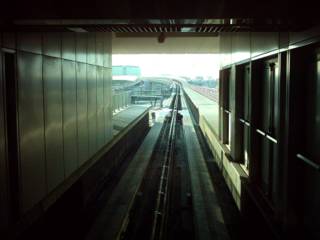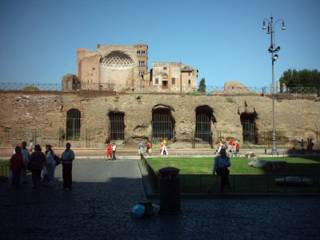
Monday, August 23: Leonardo da Vinci Airport -- When you de-plane, you have to take a shuttle train to the main terminal. It was about 7:45 am; we had left our home at about 8:30 Sunday morning. 7:45 am in Rome was 11:45 pm in Colorado. Happily, we had been so tired, Sarita and I both had slept about 4 or 5 hours on the flight. Not great sleep, but good enough for us to get by for another day.
%20-%20Shuttle_%20How%20nice%20that%20they%20pro.jpg)
On the shuttle: a pretty typical sign, from what we've seen, when you're in major cities around the world. You'll have the local language, sometimes multiple languages, but almost always English. If you're like me, and you like to learn foreign languages, it's a great way to add vocabulary!

I thought I'd capture some "typical" scenes from the various places we visited. I thought this would show pretty typical apartment buildings in Rome. . . . I was especially impressed with the vegetation! How green it is in Rome (especially compared to Denver). And how almost tropical everything looks!
%20-%20From%20the%20train%2C%20close%20to%20the%20Termini%20s.jpg)
Heading into the Termini. It was probably about 8:45. I've found that when I take a picture from a moving vehicle, it always seems to lean at the top in the direction I'm traveling. I've figured that's because my digital camera scans from top to bottom, so, whatever I'm looking at while I'm snapping the picture moves steadily right or left from top to bottom of the picture. . . . Clearly, the viaduct in the foreground was at some distance and/or the train was traveling rather slowly when this shot was taken. I've tried to shoot from bus windows when we're traveling 50 or 60 mph, and things get very strange-looking! (By the way, this is a great illustration of parallax, too! Look at the right-hand pillar, and compare its lean to the virtually nonexistent tilt of the corner of the orange building behind it!)
%20-%20Inside%20the%20train%20heading%20to%20town.jpg)
On the underground/metro train from the Termini Station to the Colosseum, two stops down.
%20-%20Entering_%20too%20bad%20all%20the%20marble%20.jpg)
About 9:15 am. The Colosseum, or "Colosseo" in Italian. As we were to learn when we got inside, the Colloseum has been virtually denuded of all its original glory. The walls had been covered in marble which has, over the centuries, been "re-purposed" for other buildings, like San Pietro (St. Peter's) Cathedral. The black holes you see in the stonework provided means for the marble to be attached.
%20-%20Inside%2C%20first%20level%2C%20looking%20dow.jpg)
Inside the Colosseum, first level, looking down toward the floor or basement area. We are almost directly across from the current entrance to the arena. Based on sun position and my recollection, you generally enter the arena from the north side. This shot was taken from the south-west side. The scaffold-walkway you see at the top of the photo, inaccessible to most people, traverses the arena and defines the general path by which gladiators would travel through the arena. Gladiators entered the arena on the west. When they left the arena--dead or alive--they (or their bodies) traveled through the eastern porthole at the far right end of the walkway (outside the picture frame).
%20-%20Looking%20up%20from%20inside_%20look%20at%20t.jpg)
Looking up from the inside. Look at that brick work! And how old is this building? (It was constructed between 72 and 80 AD by Jewish prisoners under the demands of Vespasian and Titus.)
%20-%20Looking%20across%20from%20opposite%20wher.jpg)
Straight across the arena from the entry by which modern visitors are permitted to enter. You will notice scaffolding at the upper left in the photo. It appears as if they are engaged in ongoing restoration work.
%20-%20Back%20around%20on%20the%20side%20where%20we%20.jpg)
From the second level of the Colosseum, looking north-east. Look at all that lush vegetation! . . . It sure seemed like a relatively calm Monday morning! About 10:30.
%20-%20Taken%20from%20the%20same%20general%20locat.jpg)
Same location as the previous shot, looking a bit more northward.
%20-%20From%20second%20level%2C%20above%20our%20entr.jpg)
Second level, north side, looking down. Gladiators would have traveled from right to left. . . . Notice the cross placed almost dead-center in this photo. Our guide said no Christians were killed in the Colosseum. All of those deaths occurred elsewhere, primarily at the Circus Maximus, about half a mile south of the Colosseum (by my estimation).
%20-%20From%20second%20level%2C%20above%20gladiato.jpg)
Second level, looking down from the west end. (Gladiators' exit is in the distance.) . . . According to our guide, the Colosseum was originally built to stage naval battles. Then, when the gladiatorial fights came in, they added the floor. . . . Notice the brick seating supports easily visible in the upper right of the photo and in the lower right corner. . . . The engineering achievements of this building (not to mention other buildings and works of art) impressed me greatly on this trip. I could see why the leaders of the Renaissance thought ancient Greece and Rome may have been the "peak" of civilization. . . . Truly astonishing. And especially when you consider the tools they had to work with!
.jpg)
The Colosseum was originally designed to have only three levels. But the fourth level, which you can see clearly, here, was added to accomodate the common people. Whereas the community leaders who occupied the first three levels were permitted to sit down, those on the fourth level had to stand throughout whatever events they wanted to observe.

The Colosseum is just east of the south-east end of the ancient Forum and just north-east of the Palatine ("Palatino"), the hill where the patrician (leading) families lived. The exit from the Colosseum for modern-day visitors is on the west side of the complex. We're looking across the street from the exit toward the eastern edge of the Forum. What tantalizing things may be found there? . . . We decided, first, to visit the Palatine. But first, . . .

You can't miss the Arco di Costantino--or Constantine's Arch. This photo was shot from almost the exact same spot as I shot the last one--just outside the exit from the Colosseum. Most of the art work you see on this arch remains from the monuments--like the Colosseum--whose marble Constantine raided to erect his new memorial. I take it that, already, Rome was losing its wealth and power, so, rather than cutting and engraving his own marble blocks, Constantine--as so many others--used marble that had been used before.
%20at%20the%20Colloseum%20from%20the%20s.jpg)
Looking back toward the Colosseum. Constantine's Arch is at the left. It was about 11 am (3 am Denver time). It was hot and relatively humid. We had brought no water. Happily, we had purchased some Euros before we left the United States. . . .
.jpg)
We walked down the street to the Circus Maximus ("Circo Massimo"). On the way, we tried to purchase some water. The first street vendor, just outside the Colosseum, wanted €2.50 (about $3!) for a one-litre bottle. I was very thirsty, but not quite ready to fork over that kind of money! But halfway to the Circus, I realized we were going to be in trouble if we didn't buy something. We were dehydrating quickly. Happily, we found someone who was willing to sell us a litre for "only" €2.00. . . . It seems there is nothing left of the Circus, only a long grassy park, so we went halfway back up the Via di San Gregorio and entered the Palatine. We were astonished at how few people were there. In the first half mile, I think we may have bumped into three people. Anyway. Here I am in front of what was once the governor's mansion. As before, you can see the holes in the walls that provided gripping spots for marble faces.
.jpg)
Heading up the Palatine hill, after the mansion. (If you look carefully, you can see a couple of people coming down the street toward us.) The place was empty. And quiet. And, as I recall, there was a gentle breeze. Not enough to make you completely comfortable, but a lot nicer than being on the city streets!
.jpg)
Unbelievable! A private stadium at the top of the Palatine. (The other weakness of our Q1: it does not do a good job of handling shadows and bright sunshine in a single photo. The shadows go black while the sunshine usually causes a haze. Oh, well! It was the tool we had at hand.)
.jpg)
Another view from the same spot, but looking more into the shadows.
.jpg)
From the top of the Palatine, looking north-east toward the Colosseum. What gorgeous trees!
.jpg)
Looking northwest from the northwest end of the Palatine. The northwest end of the Forum is in the foreground (beyond the currogated roof), and you can see the Monument to Victor Emmanuel II, the huge white building in the background.
.jpg)
Looking straight across the Forum to the northeast from the top of the Palatine. I wish I could give you some idea of how truly enormous the basilica--the law court you see opposite--truly is. Perhaps, if you look carefully, you can make out some of the people on the brightly-lit floor immediately in front of the arches. The place is overwhelming in size. And, we were told, there was a roof over the entire floor area that is now exposed.
.jpg)
Our camera's limitations became more and more obvious. There was simply too little light for it to capture the enormity and beauty of the Pantheon. But you get some idea from the marble work at Sarita's fee, and what little you can make out of the columns beyond her.
.jpg)
The place was packed with people. This is a view of one wall. Look at that marble work! At the top of the phot, you can just see the base of the over-arching dome. Huge! And this building was built, originally, in 27 BC, and remodeled in the early 100s AD--though most of the artwork is of more recent (Renaissance) vintage. The artist Raphael is buried here, as are many of the kings of Italy.
.jpg)
A marble Christian-era altar.
.jpg)
This is the main altar in the Pantheon at this time. But notice that it has nothing to do with pantheon--"all the gods"; it is a Christian altar. It has been a long-established policy of the Christian church to demonstrate the victory of Christ by establishing places of worship for Christ in the very places where other gods used to be worshiped. And so it is here.
.jpg)
I'm sorry. I don't even know what statue this is. But it was typical. Beautifully rendered.
.jpg)
And here, if you look carefully--here is the kind of marble work you find on the walls throughout the Pantheon.
%20-%20On%20our%20way%20out.jpg)
It was time to leave Rome. We were exhausted. But here is a last photo of the outside of the Pantheon, from the northeast side. You can see, once more, how much of the marble that used to encase the building has been removed ("repurposed") over the centuries.

A block or two down the street from the Pantheon (southeast of the Pantheon), we happened upon this amazing monument: an elephant at its base, with hieroglyphic inscription down the side of the obelisk, and a Christian cross at the top. What can it possibly be about? . . . I just decided to see if I could find out anything about it, and, indeed, I just did! See http://mp_pollett.tripod.com/roma-c1.htm and http://members.aol.com/Sokamoto31/minerva.htm for good descriptions.

After catching one city bus that broke down, then transferring to another bus, we made it to the Termini, then took the train to the port of Civitavecchia (chih-vih-tah-VECK-ee-uh). It was about 3:00 pm (7:00 am Denver time). We were exhausted.

